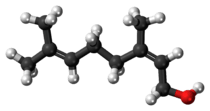Nerol
 | |
 | |
| Names | |
|---|---|
| IUPAC name
(Z)-3,7-dimethyl-2,6-octadien-1-ol | |
| Identifiers | |
| 106-25-2 | |
| 3D model (Jmol) | Interactive image |
| ChEBI | CHEBI:29452 |
| ChEMBL | ChEMBL452683 |
| ChemSpider | 558917 |
| ECHA InfoCard | 100.003.072 |
| KEGG | C09871 |
| PubChem | 643820 |
| UNII | 38G5P53250 |
| |
| |
| Properties | |
| C10H18O | |
| Molar mass | 154.25 g/mol |
| Density | 0.881 g/cm3 |
| Boiling point | 224 to 225 °C (435 to 437 °F; 497 to 498 K) at 745 mmHg |
| Except where otherwise noted, data are given for materials in their standard state (at 25 °C [77 °F], 100 kPa). | |
| | |
| Infobox references | |
Nerol is a monoterpene found in many essential oils such as lemongrass and hops. It was originally isolated from neroli oil, hence its name. This colourless liquid is used in perfumery. Like geraniol, nerol has a sweet rose odor but it is considered to be fresher.[1]
Isomeric with nerol is geraniol, wherein the double bond is trans. Nerol readily loses water to form dipentene. Nerol can be synthesized by pyrolysis of beta-pinene, which affords myrcene. Hydrochlorination of myrcene gives a series of isomeric chlorides, one of which converts to neryl acetate.
See also
References
- ↑ Karl-Georg Fahlbusch, Franz-Josef Hammerschmidt, Johannes Panten, Wilhelm Pickenhagen, Dietmar Schatkowski, Kurt Bauer, Dorothea Garbe, Horst Surburg "Flavors and Fragrances" in Ullmann's Encyclopedia of Industrial Chemistry, Wiley-VCH, Weinheim, 2002. doi:10.1002/14356007.a11_141.
This article is issued from Wikipedia - version of the 7/14/2016. The text is available under the Creative Commons Attribution/Share Alike but additional terms may apply for the media files.